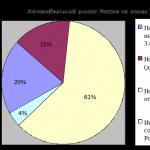A common problem is that as plants begin to bloom, more and more people complain of seasonal allergies, poor health, weakness, and nasal congestion. To prevent these ailments, we suggest studying the flowering calendar for allergy sufferers 2018. It will help you figure out when to expect problems and apply preventive measures in advance.
Symptoms of seasonal allergies in adults and children
The most common type of seasonal allergy is hay fever (or hay fever). Its symptoms may vary:
- runny or stuffy nose (allergic rhinitis);
- frequent sneezing, dry cough;
- possible pain in the ears and throat;
- frequent lacrimation, inflammation of the eyes, pain, itching (conjunctivitis).
Severe hay fever is pollen asthma. In addition, seasonal flowering can provoke angioedema and urticaria in people. Hay fever can occur at any age, in children, adults, and the elderly. Children's hay fever often develops into bronchial asthma and occurs with severe congestion of the ears and nose.
When should you expect allergies to appear?
It is very important to study the flowering schedule in advance so that the disease does not take you by surprise and disrupt your plans! Moreover, you need to take into account that there are several types of seasonal allergies:
- Spring (usually in April-May) - occurs when trees bloom;
- Summer (June-August) - during the flowering of meadow grasses, iconic ones;
- Summer-autumn (in August-September) - when weeds bloom.
In the spring there is the first “wave” of deterioration in the health of allergy sufferers, as willow, cherry and willow begin to bloom in April, and birch. Herbaceous plants are just beginning to grow at this time; in May, clover, cornflower, and chamomile are the first to bloom. A little later, lily of the valley, cinquefoil, lilac and bird cherry, rose hips and hawthorn begin to bloom.
The most difficult period for allergy sufferers is summer, when many types of plants bloom. These include carnations, elecampane, St. John's wort, and viburnum; cornflowers, clovers, and chestnuts continue to bloom actively. In July, ragweed blooms in the southern regions, motherwort, sow thistle, hemp, and wheatgrass begin to bloom. Their flowering and growth continues in August. Plus, in the days of August, fruits begin to ripen, sunflowers, foxgloves, thistles, quinoa, and nettles bloom.
When September arrives, allergies don't end as ragweed, nettle, sow thistle and quinoa are still in bloom. This continues until the end of the month (in some regions longer), and then for allergy sufferers the time comes for the disease to weaken.
In addition to the above plants, allergies are also caused by other wind-pollinated flowers, trees, and grasses (see table).
Plants within families
| Family | Plants |
|---|---|
| Birch | Birch, hornbeam, alder, hazel |
| Sycamore | Sycamore |
| Beech | Beech, chestnut, oak |
| Cereals | Soft wheat, rice, rye, corn, millet, sorghum, barley, oats, bluegrass, timothy, fescue, wheatgrass, foxtail, bromegrass, feather grass, bamboo, reed |
| Chenopodiaceae | Mary, quinoa, solyanka, beets, spinach, kochia |
| Asteraceae (weeds) | Sunflower, ragweed, lettuce, wormwood, cornflower, thistle, calendula, asteraceae, Jerusalem artichoke, string, dahlias, zinnia, rudbeckia, marigold, daisy, yarrow, chamomile, tansy, tarragon (tarragon), chrysanthemums, elecampane, edelweiss, arnica, coltsfoot, calendula, marigold, artichoke, burdock, chicory, dandelion, butterbur, milk thistle, leuzea |
Unfortunately, seasonal allergies can return in late autumn, during leaf fall. The fact is that pollen often settles on the leaves and when we walk on them, it again gets into the air.
This is general information, but you can find out specifically what is blooming and when in your city using the service https://yandex.ru/pogoda/moscow/maps/pollen. This is a very convenient Yandex map for allergy sufferers, which shows the concentration of pollen of plants and trees in different places.
Why is it important to consider the flowering schedule?
Like many diseases, seasonal allergies are easier to prevent than to treat or “bear on your feet.” Therefore, after studying the calendar, you can think over your actions - take a vacation during active flowering, go to another region, start taking antihistamines, update your first aid kit with antiallergic drugs (sprays, drops).
Shilajit is a folk preventative against allergies. It is recommended to drink it for prevention a month before active flowering.
Another tip - clean the air conditioner filters and check its operation. This will also help protect against hay fever.
When to start preparing? It is important to understand here that Russia has several climatic and natural zones, so the flowering time for each region will be different. To help, here is a pollen map for allergy sufferers, which clearly shows that in the southern regions flowering takes longer and begins earlier than in the northern ones. In the Krasnodar Territory, ragweed blooms until October; in the Crimea, other allergenic flowers bloom.
Let's look at flowering periods for some major cities and regions.

Flowering forecast in Moscow
Hazel and alder are the first to bloom in the middle zone.
- Late March - April - flowering of alder and hazel;
- End of April - birch;
- From May - apple trees and apricots, lilacs, ash, maples, oaks bloom;
- May - June - conifers, linden, poplar, willow bloom;
- From the end of May and throughout June - iconic plants;
- From the end of June - sorrel, nettle, plantain, goosefoot plants;
- In July - wormwood.
Flowering forecast in the Krasnodar region, Kuban
The warm climate, the growth of many plant species - all this makes the south of Russia the most “allergic” region of the country. Here, a difficult period for allergy sufferers lasts almost eight months, which is why the number of sick people is large - every 3rd resident is of different ages.
- From the end of February to March/April, the awakening and flowering of hazel and alder begins;
- In March, pine and willow begin to bloom;
- In April/early May - birch, poplar, elm, ash, oak, as well as wheatgrass and rapeseed, lily of the valley and feather grass bloom;
- The whole of May is the flowering of willow, acacia, the beginning of the flowering of bird cherry, cherry plum, lilac, currant, plum;
- The end of May - active flowering of grain crops;
- Summer - growth and flowering of grains and weeds;
- June - linden, chestnuts, sunflower;
- July - wormwood blooms;
- In August - quinoa, ambrosia;
- Until the end of autumn, ragweed and wormwood bloom.
The flowering season in these regions usually lasts until mid-October, but much depends on the air temperature and weather in a particular year.
Flowering forecast in St. Petersburg
Flowering forecast in Siberia, Altai, Novosibirsk
A large number of allergy sufferers have also been recorded in Siberia. This is due not only to the diversity of plants and herbs, but also to poor ecology, which undermines a person’s immunity and makes him susceptible to allergens.
- In April/May - trees and dandelions bloom;
- In summer - iconic crops;
- Late summer/early autumn - weeds bloom.
In the Altai region The main stage of flowering of allergens occurs in the April - May season. The most common tree here that causes allergies is birch.
In the Tomsk region In addition to birches, lindens, willows, and maples also bloom in April - May.
In Novosibirsk During these same months, alder and birch bloom, and in the summer, meadow and cultural symbols bloom.
Flowering forecast in Krasnoyarsk
There are three periods of flowering/pollution of allergenic plants in this region. The highest pollen content in the air is recorded in April - May, when poplar, birch, and alder bloom.
A low concentration of pollen in the air is observed in July, when iconic plants and spruce and pine bloom. The thing is that their pollen is heavy and is little carried by the wind.
The next period is July-August, at which time weeds, goosefoot and ornamental plants, wormwood, and hemp are actively blooming.
Flowering forecast in Irkutsk

Flowering forecast in Rostov-on-Don
Flowering forecast in Saratov
Flowering forecast in Vladivostok
Typically this period runs here from mid/late April to October. In addition, pollen is also blown here by wind from China.
Trees begin to bloom in April: maples, birches, alders, oaks. Then, in the first summer months, iconic and weed plants bloom, as well as sunflowers and corn. Poplar fluff actively carries pollen in June. Weeds, ragweed, and quinoa bloom from August to September.
Flowering forecast in Volgograd
The Volgograd region can boast of the longest period of allergen blooms. Here it lasts on average 8 months and is difficult to tolerate, since there are a lot of weeds. The table clearly shows what blooms and when.

Flowering forecast in Crimea
On the peninsula, the flowering period of allergenic plants is also quite long: from May to early September. In May, poplar, birch, maple, hazel, and dandelions begin to bloom, then cypress trees; from July until autumn, ragweed blooms. In July - wormwood and elderberry.
How to identify seasonal allergies
This is not easy, so it is important to observe closely to identify the underlying allergen. The manifestation of allergies is often disguised as acute respiratory infections or colds; the symptoms are largely similar: sore throat, runny nose, sneezing or cough. Flower monitoring for allergy sufferers helps identify the allergenic plant.
One more nuance - you need to pay attention if you feel unwell in dry, windy weather, but after rain you feel better. The disease will also be determined by an experienced allergist who will conduct a series of skin tests. This is an informative method that involves introducing a small dose of an allergen into the body and monitoring the reaction to it.
How are allergies treated?
- Taking medications - antihistamines;
- Eye and nasal drops help relieve swelling and improve the condition;
- Special creams and ointments eliminate skin manifestations of allergies.
- A light diet improves the patient's general condition.
- Reconsider your diet for a while. So, it is better to avoid natural honey, since it often contains plant pollen. You can also reduce the consumption of berries, fruits, even cereals, seeds, and sunflower oil.
- Maintain cleanliness and wet cleaning your home regularly. This helps eliminate pollen that comes in through windows/doors.
- Use modern air purifiers. For example, a breather that refreshes the air in the house when the windows are closed, cleans and disinfects. This device is necessary in the home of allergy sufferers, as it also protects against animal hair, exhaust gases from the street and other allergens. and you can order its quick installation on our website.

- Together with your doctor, choose the antihistamine medications that suit you. It is important to remember that some of them provoke drowsiness and reduce attention. You should not take these drugs together with alcohol, so as not to harm the body.
- In autumn or winter, undergo allergen treatment. In this case, the doctor calculates the drugs and their dosage individually.
Flowering calendar for southern Russia
| March | Apr | May | June | July | August | Sep | |
|---|---|---|---|---|---|---|---|
| Apricot, cherry plum, cypress | |||||||
| Willow | |||||||
| Cherry, oak, maple, ash, peach | |||||||
| Sycamore, lilac | |||||||
| Rapeseed, rice | |||||||
| Dandelion, walnut, beet, pine | |||||||
| Chestnut, linden, foxtail, mulberry | |||||||
| Tobacco | |||||||
| Cocklebur, reed, castor bean, rye | |||||||
| Hazel, sunflower | |||||||
| Elderberry, quinoa, wormwood, sophora | |||||||
| Ambrosia | |||||||
| Wheatgrass |
Flowering calendar for the Volga region
| March | Apr | May | June | July | August | Sep | |
|---|---|---|---|---|---|---|---|
| Elm, willow | |||||||
| Birch, oak | |||||||
| Maple, alder | |||||||
| Aspen, pine, poplar | |||||||
| Dandelion | |||||||
| Bonfire, foxtail | |||||||
| Cereals, linden | |||||||
| Hedgehog, fescue | |||||||
| Wheat grass, bluegrass | |||||||
| Timofeevka | |||||||
| Nettle, wormwood | |||||||
| Quinoa, ambrosia |
Note: flowering times depend on weather conditions and may vary by 7-14 days.
Flowering calendar for central Russia
| March | Apr | May | June | July | August | Sep | |
|---|---|---|---|---|---|---|---|
| Alder, willow, hazel | |||||||
| Aspen, poplar | |||||||
| Birch, maple | |||||||
| Oak | |||||||
| Pine | |||||||
| Dandelion | |||||||
| Bonfire, foxtail | |||||||
| Linden | |||||||
| Fescue, hedgehog, wheatgrass | |||||||
| Timofeevka, bluegrass | |||||||
| Wormwood, ragweed |
Note: flowering times depend on weather conditions and may vary by 7-14 days.
Flowering calendar for the Urals
| March | Apr | May | June | July | August | Sep | |
|---|---|---|---|---|---|---|---|
| Willow, alder, aspen | |||||||
| Birch, hazel | |||||||
| Elm, maple | |||||||
| Oak, ash | |||||||
| Foxtail, pine | |||||||
| Hedgehog, linden, bluegrass | |||||||
| fescue | |||||||
| Timofeevka | |||||||
| Rye | |||||||
| Ryegrass | |||||||
| Bonfire | |||||||
| Quinoa |
Note: flowering times depend on weather conditions and may vary by 7-14 days.
Flowering calendar for Siberia
| March | Apr | May | June | July | August | Sep | |
|---|---|---|---|---|---|---|---|
| Birch | |||||||
| Dandelion | |||||||
| Hedgehog, bluegrass | |||||||
| Timofeevka | |||||||
| White bentgrass | |||||||
| fescue | |||||||
| Wheatgrass | |||||||
| Quinoa | |||||||
| Sunflower | |||||||
| Corn | |||||||
| Sagebrush |
Note: flowering times depend on weather conditions and may vary by 7-14 days.
Flowering calendar for northwestern Russia
| March | Apr | May | June | July | August | Sep | |
|---|---|---|---|---|---|---|---|
| Hazel | |||||||
| Alder | |||||||
| Willow | |||||||
| Birch, ash | |||||||
| Foxtail | |||||||
| Poplar, elm, maple | |||||||
| Oak, bluegrass | |||||||
| Conifers | |||||||
| Other cereals | |||||||
| Sorrel | |||||||
| Linden | |||||||
| Quinoa, wormwood |
Note: flowering times depend on weather conditions and may vary by 7-14 days.
Flowering calendar for Crimea
| March | Apr | May | June | July | August | Sep | |
|---|---|---|---|---|---|---|---|
| Blue spruce, dogwood, hazel, primrose | |||||||
| Birch, peach | |||||||
| Honeysuckle | |||||||
| Oleander | |||||||
| Wisteria, chestnut, peony, lilac | |||||||
| Rose | |||||||
| Spanish gorse, pink chestnut | |||||||
| Geranium, Judas tree, fescue | |||||||
| Sagebrush | |||||||
| Crocus, cannas | |||||||
| Chrysanthemums | |||||||
| Ambrosia |
Note: flowering times depend on weather conditions and may vary by 7-14 days.
Analyzing the compatibility of qualities will help bring harmony to your relationship with a loved one. The science of numerology will help us with this. You will learn even more about compatibility from numerology than from psychology.
The ability to build and maintain relationships is the basis of our lives. With the help of numerology, the science of the magic of numbers, you can calculate the compatibility of two people with each other, and understand whether they can exist peacefully and happily together. Numerology will help you find out your partner’s true impulses, hidden abilities and needs - you just need to find out his digital code and compare it with yours.
Using the personal compatibility map, you can conduct a quick analysis of the possibilities of your partnership. In close relationships, a diminutive name is often used, therefore, calculations should be made based on these forms.
Enter names
Compatibility of May and Lipa
Compatibility number 4
In a couple influenced by the vibrations of the four, partners are united by hard work, determination, energy and loyalty to tradition. This combination is well suited for business relationships, and in friendships and love unions the four bring calmness, which is not conducive to strong passions and the manifestation of emotions. There are also advantages to this: relationships do not take a lot of mental strength, there are no crises or long downturns in them.
The participants of such a union succeed in their work. The vibrations of the four help them plan their time wisely, set priorities correctly, and organize the work of other people.
The influence of the four also contributes to success in entrepreneurial activity, since it helps to make timely decisions, fight internal apathy, and simply gives energy. Favorable areas for work are construction, farming, and finance.
For a complete analysis of name compatibility, now let’s take a closer look at each number of the name Mai and Lipa.
May name number 8
Symbolizes entrepreneurship, pedantry, constancy of habits and hobbies, respect for the laws and orders established in society. Uranus favors activities in the sphere of big politics and big business, foreshadowing public recognition and material benefits. These people do not like anything superficial and temporary, preferring order and stability in everything. They do not like to depend on other people; they achieve everything on their own. The desire for wealth often becomes the main driving force in their lives. Having successfully completed one task, these people immediately move on to the next. They are characterized by stubbornness, a sober view of things, and a rational mindset. They are prudent, careful, punctual and methodical. Very hardworking and persistent in achieving goals. Having learned to correctly distribute work between subordinates and employees, leaving themselves only with questions of general management, they are able to achieve great heights.
The number of the name Lipa is 5
Indicates spiritual freedom and independence of action. Mercury gives people a lively and resourceful mind. They value acquired and accumulated experience much more than outside advice. They show initiative in everything, find the rational grain in any matter, and strive to try their hand at rare professions. Swift and mobile: they think quickly, make decisions quickly, quickly move from words to action. They are overwhelmed by a thirst for knowledge, have a sharp critical mind and resourcefulness, but are not capable of routine, monotonous work, and quickly become despondent from failures. Natural charm makes them the life of the party, and their bright personality can lift them to the heights of popularity.
Most of all they love travel and adventure. They are not very economical and practical. Often the number 5 indicates a philosophical mindset, sometimes it indicates frivolity and promiscuity.
How does linden blossom? Many people ask themselves this question, because the pleasant, delicate honey aroma attracts and captivates everything around them. Linden is one of the most unpretentious, long-lived trees, which can grow and bloom in one place for up to 500 years.
Linden tolerates different climatic conditions and any care procedures well. Those who want to see a luxurious plant in their yard that blooms luxuriantly should understand that it mainly loves sunny and warm areas.
Linden tree: description
Linden characteristics:
- The leaves of the tree are oval or heart-shaped. When they bloom, stipules appear on them, which tend to quickly fall off.
- Flowers are collected in inflorescences in the form of umbrellas. Miniature nut-shaped fruits.
- Linden has about 40 species, distributed throughout different parts of Europe and Asia. Some varieties are found in the Crimea.
- The linden tree is also popular in Russia: Moscow region, Altai, Caucasus, Central Russia.
- Most varieties are bred and adapted to bloom in certain climates. They also have certain properties that are necessary to take root in the desired territory.
Timing and characteristics of linden flowering:
- Linden blooms in small inflorescences from June to July. The specific time depends on the climatic conditions of growth.
- Thus, the flowering of trees in the south and north is significantly different- the beginning of June and the end of July, respectively.
- and in the middle zone It begins to bloom from the end of July and continues until the beginning of July.
- There are an average of 7-8 flowers in one inflorescence delicate cream color.
- The tree blooms for 12-14 days. Flowering does not occur quickly.
In favorable conditions, a flowering tree can be seen only 18-20 years after planting.
Why doesn't the linden tree bloom?
It is worth considering that most linden varieties do not tolerate the southern climate well. An incorrectly selected variety may not begin to bloom in such regions at all. Many varieties are also characterized by slow growth, which is often confused with a disease that caused a lack of flowering.
Common reasons for lack of flowering are:
- incorrectly selected variety for certain climate conditions;
- excessive or low soil moisture;
- incorrectly chosen landing site.
The same reasons may also be why the linden tree does not bloom every year.
How to grow more crops?
Any gardener and summer resident is pleased to receive a large harvest with large fruits. Unfortunately, it is not always possible to obtain the desired result.
Plants often lack nutrition and useful minerals
It has the following properties:
- Allows increase productivity by 50% in just a few weeks of use.
- You can get a good one harvest even on low-fertility soils and in unfavorable climatic conditions
- Absolutely safe
Linden blossom: collection and preparation
Linden blooms mainly between June and July. Inflorescences are yellowish in the shape of half-umbrellas. Near the inflorescences there are narrow leaves - bracts. There is a honey aroma that fills the entire street. The smell of linden attracts bees.
When and how to harvest inflorescences?
It is important to take the time of harvest seriously. It is worth picking linden blossoms when most of the flowers are already open, and the rest are at the stage of bud formation.
Rules for collecting linden blossom:
- If you start collecting at a time when the flowers have already begun to fade, then the petals will quickly fall off and will not bring any benefit.
- It is better to collect raw materials in environmentally friendly places or at least in those near which there are no highways or industrial buildings.
- Material collection is carried out only in dry weather. There should be no dew or other moisture on the leaves or flowers.
- It is better to cut the inflorescences with pruning shears or garden scissors. It is not advisable to break them off.
- Review before drying collected twigs and remove excess.
How to dry it properly?
To obtain high-quality raw materials, follow the recommendations:

In order for the raw material to dry quickly and dry thoroughly, you need to stir it constantly.
Electric dryers are also used for drying. To prevent linden blossom from losing its properties, use temperature not higher than +38°C.
The finished dried material is stored for 12 months in a cool room. For storage, it is better to choose fabric or paper bags.
Linden honey
Linden honey has a persistent, pleasant aroma. The color of this honey is golden-greenish or white-cream. The color of honey, its quality and taste are influenced by the type of linden and growing conditions.
Many varieties of linden also contain beneficial amino acids.
In addition, linden honey has a positive effect on:
- organs of the respiratory system;
- work of the gastrointestinal tract;
- kidneys;
- liver.
The components of honey improve the functioning and tone the blood vessels and muscles of the heart. Consuming honey has a positive effect on the nervous system and vision. It is also used externally for eczema and burns. The only contraindication to consuming honey is allergic reaction to its components.
Beneficial properties of linden flowers
Linden has been famous for its beneficial and medicinal properties for several centuries:
- Essential oil linden blossom spreads throughout the room and has a beneficial effect on the human nervous system. Therefore, it is useful not only to drink linden drinks, but also to walk along linden alleys.
- Linden decoctions and teas They have an analgesic, tonic, and organ stimulating effect. Has anti-inflammatory and diaphoretic effect.
- Cleanses blood and internal organs from toxins, improves the functioning of the gastrointestinal tract.
- Baths and teas used as a sedative and analgesic.
- As lotions used for external use for ulcers, burns, and sore joints.
- Benefits for the female body: the presence of estrogen improves hormonal levels and improves the menstrual cycle. Women also use linden blossom to prepare various cosmetic products.
Contraindications
Linden practically cannot harm the body, but several factors still need to be taken into account:
- Linden drinks should not be consumed daily, as this will cause problems with the functioning of the heart muscle.
- Individual intolerance to linden components.
Ways to use linden blossom
 To prepare it, you need to pour 2 tbsp into a glass of boiling water. l. linden color. After the drink has stood and infused for 15 minutes, it is ready to drink.
To prepare it, you need to pour 2 tbsp into a glass of boiling water. l. linden color. After the drink has stood and infused for 15 minutes, it is ready to drink.
The medicinal properties of the drink will improve your well-being and have healing qualities:
- strengthen the immune system;
- improve complexion;
- help relieve swelling;
- quickly overcome colds and infectious diseases;
- It brings special benefits to the body of pregnant women.
Linden decoction
You will need 400 ml of water and 1-1.5 spoons of linden blossom. The flowers are poured into water and allowed to boil, then kept on low heat for 8-10 minutes. The broth is filtered. The product is used as healing and refreshing drink and as a cosmetic product.
Linden infusion
It is used both as a separate drink and as a therapeutic aid for coughs and colds.
 To prepare:
To prepare:
- add 2-3 tbsp to 250 ml of hot water. l linden blossom;
- Heat the mixture in a water bath for 15 minutes;
- then leave to cool for 40 minutes;
- After it has cooled, strain well;
- measure the amount of infusion received and add to 250 ml.
Take 200-250 ml 3 times a day after meals.
Areas of application of linden
Linden fruits and flowers in cosmetology
Cosmetology is one of the popular areas of application of linden leaves, honey and fruits.
The rejuvenating function of linden-based products is possible thanks to the special phytohormones it contains:

Cosmetic products have the following properties:
- give the skin elasticity and nourish it;
- eliminate the first wrinkles;
- soothe irritated skin;
- moisturize and rejuvenate;
- tone up.
Linden in construction
Wood is valued as a building material due to its properties:
- sands quickly;
- is a natural antiseptic;
- has a low thermal conductivity.
These characteristics are perfect for finishing buildings whose temperature significantly exceeds the average temperature in the room: baths, saunas.
Due to its softness and pliability during grinding, it is ideal as a carving material. Decorative products are of high quality due to the light shade of wood, which practically does not change its color.
The material, although in demand, is considered highly specialized. It is also used for the manufacture of musical instruments, veneer, lining, eurolining.
Types of linden
More than 30 varieties of linden are known in the world.
The most common of them are:
- Common linden. It has the properties and characteristics of large-leaved and small-leaved linden. But there are a few differences. Blooms 2.5 weeks earlier. The crown and trunk grow much faster. It tolerates low temperatures well and can grow in almost any conditions. Compared to small-leaved linden, the leaves and crown are larger and wider.
- Linden is heart-shaped. It is also called heart-leaved. It grows in the Crimea and the Caucasus, in Russia and Western Europe. It got its name because of the heart-shaped leaves. It grows up to 30 meters, the crown in diameter is up to 15 meters. Flowering time depends on the place of growth - June - July. The flowers are small, up to 6-7 in one inflorescence. Resistant to drought and frost. One tree can live up to 400-500 years.
- Linden flat-leaved. Grows up to 40 meters. It blooms a little later than ordinary linden varieties. The tree grows mainly in Moldova, Ukraine, the Caucasus, Central, Southern and Western Europe. Mainly used for landscaping and landscaping.
- Felt linden. It grows mainly in the Balkans, Ukraine, Asia Minor, and Western Europe. It is also found in the Crimea and the Caucasus. The best neighbors for linden will be oak, maple, and clear. It can grow up to 32 meters, both the crown and the trunk have the correct shape. The young bark is smooth to the touch and has a dark gray tint. Linden leaves are slightly pointed, up to 8 cm long. It blooms in July, the flowers are light cream in color. When growing, it tolerates both light and shaded areas. A healthy tree can live up to 200 years.
If you have long dreamed of visiting the Maldives, but cannot afford it, do not despair. I will tell you a place that can safely be called a paradise island. Read my review about the trip to Koh Lipe.
Ko Lipe in May - sunny and hot
The fabulous island can only be reached by boat, sailing past the most picturesque places. I arrived early in the morning and immediately felt the intense humidity typical of the tropics. And how hot it was! 33-35°C is a daily challenge for most people. Nothing much changed at night - 26-27 degrees Celsius. All the inconveniences are compensated by the beauty of Ko Lipe. It seemed to me that I was in a fairy tale. The Andaman Sea is an incredible combination of blue shades.

The best beaches in Ko Lipe in May
Koh Lipe has three beautiful beaches that are definitely worth a visit. Take your camera with you for a photo shoot. So:
- Sunset Beach (lagoon with huge rocks poking out of the water);
- Sunrise Beach (from here you can enjoy views of the neighboring tropical island of Koh Adang);
- Pattaya Beach (a large number of vacationers gather here).
I liked Pattaya Beach for its developed infrastructure. Here life is in full swing. Any tourist will find something to suit his taste. For a small fee you can get a Thai massage while admiring the sea. Thais are professionals in their field. There are many restaurants on the coast that serve national cuisine. Seafood is always fresh and tasty.
Bring swimming gear with you to master snorkeling. The Andaman Sea is teeming with colorful, nimble fish that you just want to touch with your hand! And if you want to eat fish, then go fishing and enjoy your own catch. Be sure to sleep in a hammock under a palm tree at least once. The sound of the surf will quickly break you into a serene sleep. Feel like Robinson!


















